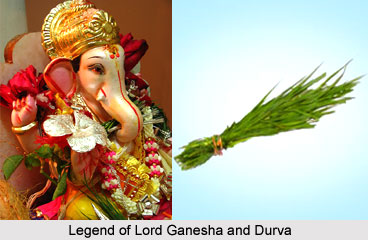 The Mahapuranas and the Upapuranas mention the legend of Lord Ganesha and Durva and the reason of worshipping the Lord with Durva grass or Bermuda grass (Cynodon Dactylon). The legend states that once there was a demon or asura named Analasur. He created havoc on earth and created problems for the saints and sages. Then all the gods, deities and sages prayed to Lord Ganesha for help.
The Mahapuranas and the Upapuranas mention the legend of Lord Ganesha and Durva and the reason of worshipping the Lord with Durva grass or Bermuda grass (Cynodon Dactylon). The legend states that once there was a demon or asura named Analasur. He created havoc on earth and created problems for the saints and sages. Then all the gods, deities and sages prayed to Lord Ganesha for help.
As the deity confronted the demon, Analasur charged at Ganesha to attack him. The Lord, in return, devoured the asura in order to save the world and the humans. But this resulted in a burning sensation inside His stomach. The feeling was so intense that the burning could not be alleviated by any means and the Lord was unable to bear the pain. All the gods and deities tried to relieve the pain but all their attempts went in vain. Then the revered Sage Kashyapa came forward and asked Him to swallow 21 stacks of Durva grass, which were infused with sacred mantras. After Lord Ganesha consumed the blessed grass, the burning pain was relieved.
Thus 3 to 5 stocks of Durva grass is offered to the elephant headed lord during the worship of Lord Ganesha and on Ganesh Chaturthi. The sacred Durva grass contains various medical and curative characteristics which help in curing problems related to stomach as well as mental disorders. The grass functions as an antibiotic. It is also believed that even touching and viewing Durva grass or Bermuda grass provides mental peace.
This article is a stub. You may enrich it by adding more information to it. You can send your write-up at content@indianetzone.com




















